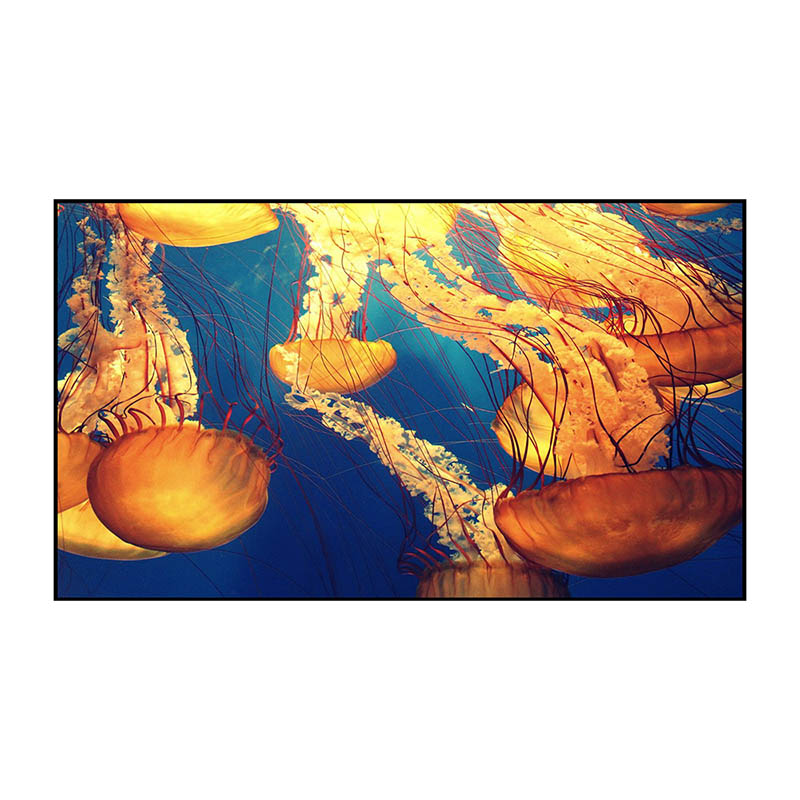Features of Fixed Frame Screens
2024-07-15
A fixed frame screen is a type of projection screen used in home theaters, conference rooms, and other settings where high-quality video projection is desired. Unlike retractable screens, fixed frame screens remain stationary once installed. Here’s an overview of fixed frame screens, their features, benefits, and considerations:
Features of Fixed Frame Screens:
1. Screen Material:
- High-Quality Fabric: Typically made from materials optimized for high-definition video projection, such as matte white, gray, or acoustically transparent fabrics.
- Gain and Viewing Angle: Different screen materials offer varying levels of gain (brightness) and viewing angles to suit different projector types and room lighting conditions.
2. Frame Construction:
- Rigid Frame: The screen material is stretched and fixed to a sturdy frame made of aluminum or steel.
- Tensioning System: Some models include a tensioning system to ensure the screen surface remains flat and smooth, enhancing image quality and reducing wrinkles.
3. Design and Aesthetics:
- Slim Bezel: Features a thin, often black velvet or matte finish bezel surrounding the screen to enhance contrast and minimize distractions.
- Customizable Size: Available in various diagonal sizes and aspect ratios (e.g., 16:9, 2.35:1) to accommodate different projector setups and viewing preferences.
4. Installation:
- Wall Mounting: Typically mounted directly onto walls using brackets or wall studs, ensuring stability and a seamless appearance.
- Fixed Position: Once installed, the screen remains stationary and does not retract or fold, providing a dedicated viewing area.
Benefits of Fixed Frame Screens:
- Image Quality: Provides a flat, wrinkle-free surface for sharp and accurate image reproduction, ideal for high-definition and 4K projectors.
- Aesthetics: Enhances the look of home theaters and conference rooms with a professional and sleek appearance.
- Permanent Setup: Offers a dedicated viewing area without the need to retract or store the screen, ensuring consistent performance.
Considerations:
- Space Requirement: Requires sufficient wall space for installation, which may limit placement options compared to retractable screens.
- Room Lighting: Screen material and gain characteristics should be chosen based on ambient light conditions in the room to optimize image brightness and contrast.
- Maintenance: Occasional cleaning and maintenance of the screen fabric to remove dust and maintain image clarity.
Popular Uses:
- Home Theaters: Creates a cinematic experience at home with immersive video and audio quality.
- Conference Rooms: Provides clear, professional presentations and video conferencing capabilities.
- Gaming Rooms: Enhances gaming experiences with large, vibrant visuals and minimal input lag.
Growth and Trends:
- Ultra-Short Throw Compatibility: Designed to accommodate ultra-short throw projectors, which require specific screen materials and designs.
- Motorized Options: Some fixed frame screens are available with motorized masking systems or variable aspect ratios for enhanced versatility.
- Acoustic Transparency: Increasing availability of screens that allow sound to pass through, enabling placement of speakers behind the screen for improved audio performance.
Fixed frame screens offer a high-performance solution for displaying movies, presentations, and other multimedia content with clarity and precision. When choosing a fixed frame screen, consider your room dimensions, projector specifications, and viewing preferences to select the best screen size and material for your needs.



